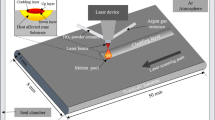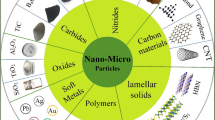Abstract
This manuscript reports an evaluation of the effects of simple chemical-heat treatments on the deposition of different ceramic coatings, i.e., TiO2, CaTiO3 and CaP, on commercially pure titanium (cp-Ti) and Ti6Al4V and the influence of the coatings on cells interaction with the surfaces. The ceramic materials were prepared by the sol-gel method and the coating adhesion was analyzed by pull-off bending tests. The wettability of positively or negatively charged surfaces was characterized by contact angle measurements, which also enabled the calculation of the surface free energy through the polar-apolar liquids approach. Both acid and alkaline treatments activated the cp-Ti, whereas Ti6Al4V was only activated by the alkaline treatment. Such treatment led to increased hydrophilicity with inhibition of the fibroblastic response on Ti6Al4V. On the other hand, osteoblastic cells adhered to and proliferated on the positively and negatively charged surfaces. The maximum adhesion strength (~ 3400 N) was obtained with a negative Ti6Al4V-CaTiO3-CaP multilayer surface.
Graphical Abstract







Similar content being viewed by others
References
Wu C, Chen Z, Wu Q, Yi D, Friis T, Zheng X, Chang J, Jiang X, Xiao Y. Clinoenstatite coatings have high bonding strength, bioactive ion release, and osteoimmunomodulatory effects that enhance in vivo osseointegration. Biomaterials. 2015;71:35–47.
Echeverry Rendón M, Galvis O, Giraldo DQ, Pavón J, López-Lacomba JL, Jiménez-Piqué E, Anglada M, Robledo SM, Castaño JG, Echeverría F. Osseointegration improvement by plasma electrolytic oxidation of modified titanium alloys surfaces. J Mater Sci Mater Med. 2015;26:72.
Nayak S, Dey T, Naskar D, Kundu SC. The promotion of osseointegration of titanium surfaces by coating with silk protein sericin. Biomaterials. 2013;34:2855–64.
Rungsiyakull C, Li Q, Sun G, Li W, Swain MV. Surface morphology optimization for osseointegration of coated implants. Biomaterials. 2010;31(Issue 27):7196–204.
Thein-Han LJ, Xu HH. Calcium phosphate cement with biofunctional agents and stem cell seeding for dental and craniofacial bone repair. Dent Mater. 2012;28:1059–70.
Guha AK, Singh S, Kumaresan R, Nayar S, Sinha A. Mesenchymal cell response to nanosized biphasic calcium phosphate composites. Colloids Surf B Biointerfaces. 2009;73:146–51.
Dorozhkin SV. Biocomposites and hybrid biomaterials based on calcium orthophosphates. Biomatter. 2011;3:56.
Mussano F, Genova T, Munaron L, Faga MG, Carossa S. Ceramic Biomaterials for Dental Implants: Current Use and Future Perspectives. 2016. doi:10.5772/62701.
Metikos-Hukovic M, Tkalcec E, Kwokal A, Piljac J. An in vitro study of Ti and Ti-alloys coated with sol-gel derived hydroxyapatite. Surf Coat Technol. 2003;165:40–50.
Goriainov V, Cook R, Latham JM, Dunlop DG, Oreffo ROC. Bone and metal: An orthopaedic perspective on osseointegration of metals. Acta Biomaterialia. 2014;10:4043–57.
Wanga Y, Yub H, Chena C, Zhaoa Z. Review of the biocompatibility of micro-arc oxidation coated titanium alloys. Mater. Des. 2015;85:640–652.
Blanquer A, Hynowska A, Nogués C, Ibáñez E, Sort J, Baró MD, Ozkale B, Pané S, Pellicer E, Barrios L. Effect of surface modifications of Ti40Zr10Cu38Pd12 bulk metallic glass and Ti-6Al-4V alloy on human osteoblasts in vitro biocompatibility. PLoS ONE. 2016;11:e0156644.
Zhao CQ, Wu SQ, Lu YJ, Ga YL, Guoa S, Lin JJ, Huang TT, Lin JX. Evaluation to the effect of B2O3–La2O3–SrO–Na2O–Al2O3 bonding agent on Ti6Al4V–porcelain bonding. J Mech Behav Biomed Mater. 2016;63:75–85.
Mandracci P, Mussano F, Rivolo P, Carossa S. Surface treatments and functional coatings for biocompatibility improvement and bacterial adhesion reduction in dental implantology. Coating. 2016;6:7. doi:10.3390/coatings6010007.
Shukla AK, Balasubramaniam R. Effect of surface treatment on electrochemical behavior of CP Ti, Ti–6Al–4V and Ti–13Nb–13Zr alloys in simulated human body fluid. Corros Sci. 2006;48:1696–720.
Zhou R, Wei D, Yang H, Cheng S, Feng W, Li B, Wang Y, Jia D, Zhou Y. Osseointegration of bioactive microarc oxidized amorphous phase/TiO2 nanocrystals composite coatings on titanium after implantation into rabbit tibia. J Mater Sci Mater Med. 2014;25:1307–18.
Chen X-B, Li YC, Plessis JD, Hodgson PD, Wen C. Influence of calcium ion deposition on apatite-inducing ability of porous titanium for biomedical applications. Acta Biomater. 2009;5:1808–20.
Minagar S, Wang J, Barndt CC, Ivanova EP, Wen C. “Cell response of anodized nanotubes on titanium and titanium alloys”. J Biomed Mater Res Part A 2013;101:2726–39.
Diefenback M, Muckley T, Shrader C, Schmidt J, Zankovych S, Bossert J, Jandt KD, Faucon M, Finger U. The effect of plasma chemical oxidation of titanium alloy on bone-implant contact in rats. Biomaterials. 2011;32:8041–7.
Echiato-filho AJ, da Silva Vieira Marques I, dos Santos DM, Matos AO, Rangel EC, da Cruz NC, Barão VAR. Effect of nonthermal plasma treatment on surface chemistry of commercially-pure titanium and shear bond strength to autopolymerizing acrylic resin. Mater Sci Eng C Mater Biol Appl. 2016;60:37–44.
Kokubo T, Yamaguchi S. Bioactive titanate layers formed on titanium and its alloys by simple chemical and heat treatments. Open Biomed Eng J. 2015;9:29–41.
Wang XJ, Li YC, Lin JG, Hodgson PD, Wena CE. Apatite inducing ability of titanium oxide layer on titanium surface: the effect of surface energy. J Mater Res. 2008;23:1682.
Owens DK, Wendt RC. Estimation of the surface free energy of polymers. J Appl Polym Sci. 1969;13:1741.
Nascimento RM, Faita FL, Agostini DLS, Job AE, Guimarães FEG, Bechtold IH. Production and characterization of natural rubber–Ca/P blends for biomedical purposes. Mater Sci Eng C Mater Biol Appl. 2014;39:29–34.
Nascimento R, Carvalho V. Dynamics of the interaction between body fluid and Cp-Ti: the influence of surface functionalization in the first stages of osseointegration. Braz J Biomed Eng. 2014;30:83–90.
Nascimento R, Carbonari M, Florentino A. Development of a high adhesion bioactive coating for implant dentistry purposes. Implant News. 2013;10:6.
Zar, JH Biostatistical Analysis. 4ª ed. Upper Saddle River, NJ:Prentice Hall; 1999.
Gennes PG. Wetting: statics and dynamic. Rev Mod Phy. 1985;57:827–63.
Wenzel RN. Resistance of solid surfaces to wetting by water. Ind Eng Chem. 1936;28:988.
Gittens RA, Scheideler L, Rupp F, Hyzy SL, Geis-Gerstorfer J, Schwartz Z, Boyan BD. A review on the wettability of dental implant surfaces II: Biological and clinical aspects. Acta Biomaterialia. 2014;10:2907–18.
Svetlana AS, Daniel S, Erik H, Markus R. Evaluation of wettability and surface energy of native Nitinol surfaces in relation to hemocompatibility. Mater Sci Eng C. 2013;33:127.
Park JH, Wasilewski CE, Almodovar N, Olivares-Navarrete R, Boyan BD, Tannenbaum R, Schwartz Z. The response to surface wettability gradients induced by chitosan nanofilms on microtextured titanium mediated by specific integrin receptors. Biomaterials. 2012;33:7386.
Gittens RA, Olivares-Navarrete R, Cheng A, Anderson DM, McLachlan T, Stephan I, Geis-Gerstorfer J, Sandhage KH, Fedorov AG, Rupp F, Boyan BD, Tannenbaum R, Schwartz Z. The roles of titanium surface micro/nanotopography and wettability on the differential response of human osteoblast lineage cells. Acta Biomaterialia. 2013;9:6268–77.
Zhao G, Raines Al, Wieland M, Schwartz Z, Boyan BD. Requirement for both micro-and submicron scale structure for synergistic responses of osteoblasts to substrate surface energy and topography. Biomaterials. 2007;28:2821.
Rakngarm A, Miyashita Y, Mutoh Y. Formation of hydroxyapatite layer on bioactive Ti and Ti–6Al–4V by simple chemical technique. J Mater Sci Mater Med. 2008;19:1953–61.
Acknowledgements
The authors are indebted to Dr. Douglas Monteiro and Dr. Elisabete Zaniquelli (USP—Ribeirao Preto); Dr. Dayse Santos and Juliana Ferreira (UNESP—Bauru); Dr. Ligia Mota, Dr. Ramon Kaneno, Dr. Tereza Peraçoli and Dr. Margarida Saeki (UNESP-Botucatu), Dr. Marcelo Carbonari (INSPER) and Angela Giampedro (USP-Sao Carlos) for all the support. They also acknowledge the financial support provided by Brazilian Agencies CAPES, CNPq and FAPESP.
Author information
Authors and Affiliations
Corresponding author
Ethics declarations
Conflict of interest
The authors declare that they have no competing interest.
Electronic supplementary material
Rights and permissions
About this article
Cite this article
do Nascimento, R.M., de Carvalho, V.R., Govone, J.S. et al. Effects of negatively and positively charged Ti metal surfaces on ceramic coating adhesion and cell response. J Mater Sci: Mater Med 28, 33 (2017). https://doi.org/10.1007/s10856-017-5848-0
Received:
Accepted:
Published:
DOI: https://doi.org/10.1007/s10856-017-5848-0




